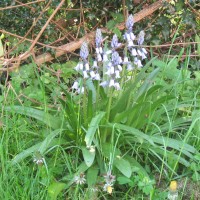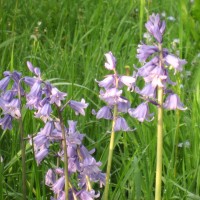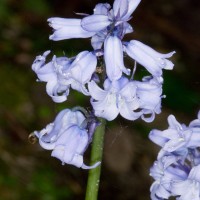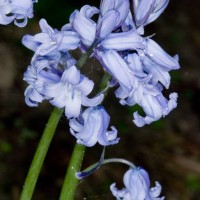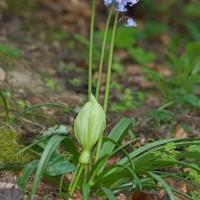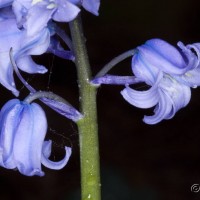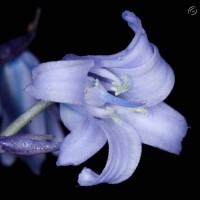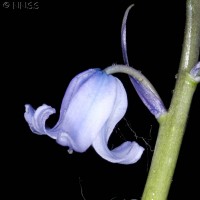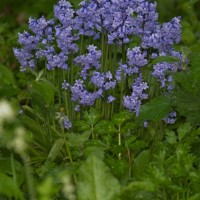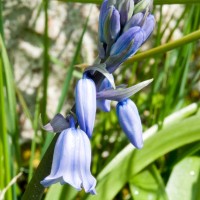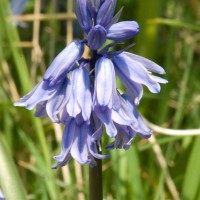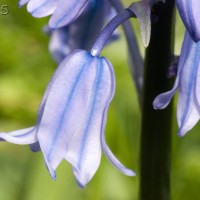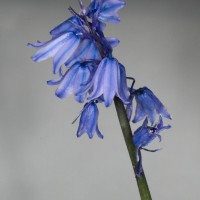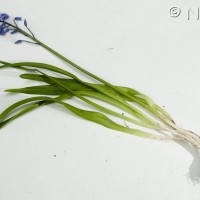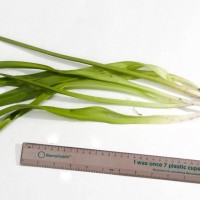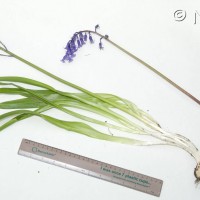
Garden Bluebell - Hyacinthoides hispanica
Expand and collapse the sections below by clicking on the title or + / - icons.
Short description of Hyacinthoides hispanica, Garden Bluebell
Like the native Bluebell, but with broader leaves, a larger, less one-sided, erect spike of paler, scentless, more campanulate flowers, and blue anthers. Hybrids may be intermediate in all characters.
Impact summary: Hyacinthoides hispanica, Garden Bluebell
The main concern is that extensive hybridization with the native Bluebell H. non-scripta will threaten the integrity of the latter species, which in the UK is highly-valued in landscape and cultural terms. Some however believe that the problem may be overstated. The belief that alien Bluebell taxa will outcompete native H. non-scripta remains to be proven.
Habitat summary: Hyacinthoides hispanica, Garden Bluebell
Waysides, woodland edges and entrances, churchyards, cemeteries, parks, wastelands etc., usually associated with human habitation or the dumping of garden waste.
Overview table
| Environment | Terrestrial |
|---|---|
| Species status | Non-Native |
| Native range | Southwestern Europe |
| Functional type | Land plant |
| Status in England | Non-Native |
| Status in Scotland | Non-Native |
| Status in Wales | Non-Native |
| Location of first record | v.c.61 (Barmby Bank, Selby) |
| Date of first record | 1875 |
Origin
A European endemic, native to the western Iberian peninsula and possibly north Africa. Naturalized elsewhere in S. and W. Europe, also considered ‘established’ in Belgium, Germany and Norway.
First Record
Introduced into GB gardens by 1683, and known from the wild by 1909. The hybrid was first reported in 1963.
Pathway and Method
Often planted in the wild (the hybrids are widely sold as native Bluebells) or introduced into wild places with garden waste. Whilst patches increase in size they tend not to disperse far from their site of introduction. Where this species occurs in proximity to the native Bluebell or hybrids, fertile intermediates arise.
Species Status
Both H. hispanica and H. x massartiana hybridise freely with the native Bluebell producing fertile seed. Both alien taxa are clearly increasing, and although many localities are within pollination distance of native Bluebell woods, large-scale degradation of important native Bluebell populations has not yet occurred. One hopes that increasing public awareness will slow down the introduction of new material into the wild.
Dispersal Mechanisms
Apparently a poor disperser, but there is an ongoing supply to the wild of new material through planting and the dumping of garden waste. H. hispanica and its hybrids are most likely to spread along lines of human habitation.
Reproduction
Spreading by seed and offsets. Seed produced by hybrids between the native Hyacinthoides non-scripta and H.hispanica is fertile.
Known Predators/Herbivores
The BRC Database of Insects and their Food Plants lists three generalist noctuid moths, Eugnorisma glareosa, Paradiarsia glareosa and Xestia sexstrigata,two uncommon Tortricid moths Hysterophora maculosana and Eana incanana,and two ‘Narcissus Bulb Flies’ Merodon equestrisandEumerus tuberculatusas feeding on H.non-scripta or the genus Hyacinthoides as a whole. Native bluebells will be eaten by deer (especially Muntjac) and pigs (including Wild Boar) in woodand situations, and one assumes that Spanish bluebells and hybrids would also be taken. Badgers have been known to eat Bluebell bulbs.
Resistant Stages
Leaves die back after flowering, leaving seeds in their papery receptacles through the autumn. The longevity of seed is not known.
Habitat Occupied in GB
Waysides, woodland edges and entrances, churchyards, cemeteries, parks, wastelands etc, usually with some connection with human influence or habitation, or where garden waste has been tipped.
Widespread, though rather less so in some upland areas of Scotland and northern England. H. hispanica is almost certainly over-recorded for its more common hybrid with the native Bluebell, Hyacinthoides x massartiana. There may also be a few places where it is under-recorded owing to recorders’ belief that all local specimens are referable to the hybrid.
Environmental Impact
Ecologically, the erosion by hybridisation of the integrity of a native species with a limited worldwide distribution is the main concern. This would seem most likely to occur where ancient woodlands lie in proximity to cities or other human habitation.
Health and Social Impact
The much-feared degradation of the integrity of native Bluebell woods by introgression with this species has yet to occur, but would have significant impact on a well-loved and culturally-important GB landscape. Information on health impacts tends to refer to the native H.non-scripta, which is said to be poisonous, but have diuretic and styptic properties, and also have sap which can be used as a glue and as a starch.
Economic Impact
None known.
Identification
Stace, C.A. (2010) New flora of the British Isles, Third Edition, Cambridge University Press, Cambridge.
Biology, ecology, spread, vectors
Preston, C.D., Pearman, D.A. & Dines, T.D. (2002) New Atlas of the British and Irish Flora, Oxford University Press, Oxford.
http://sppaccounts.bsbi.org.uk/content/hyacinthoides-non-scripta-h-hispanica-h-x-massartiana
http://species.bsbi.org.uk/html/hyacinthoides_non-scripta.html
http://en.wikipedia.org/wiki/Spanish_Bluebell
Management and impact
http://www.bsbi.org.uk/Bluebells__Hyacinthoides__in_vc94.pdf
http://species.bsbi.org.uk/html/hyacinthoides_non-scripta.html
http://www.habitas.org.uk/invasive/species.asp?item=2186
http://www.plantlife.org.uk/uploads/documents/Bluebells_lflt_2009.pdf
General
Preston, C.D., Pearman, D.A. & Dines, T.D. (2002) New Atlas of the British and Irish Flora, Oxford University Press, Oxford.
Spotted this species?
Distribution map
View the Distribution map for Garden Bluebell, Hyacinthoides hispanica from BSBI

